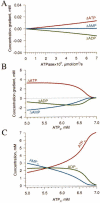Nucleotide-gated KATP channels integrated with creatine and adenylate kinases: amplification, tuning and sensing of energetic signals in the compartmentalized cellular environment
- PMID: 14977185
- PMCID: PMC2760266
- DOI: 10.1023/b:mcbi.0000009872.35940.7d
Nucleotide-gated KATP channels integrated with creatine and adenylate kinases: amplification, tuning and sensing of energetic signals in the compartmentalized cellular environment
Abstract
Transmission of energetic signals to membrane sensors, such as the ATP-sensitive K+ (KATP) channel, is vital for cellular adaptation to stress. Yet, cell compartmentation implies diffusional hindrances that hamper direct reception of cytosolic energetic signals. With high intracellular ATP levels, KATP channels may sense not bulk cytosolic, but rather local submembrane nucleotide concentrations set by membrane ATPases and phosphotransfer enzymes. Here, we analyzed the role of adenylate kinase and creatine kinase phosphotransfer reactions in energetic signal transmission over the strong diffusional barrier in the submembrane compartment, and translation of such signals into a nucleotide response detectable by KATP channels. Facilitated diffusion provided by creatine kinase and adenylate kinase phosphotransfer dissipated nucleotide gradients imposed by membrane ATPases, and shunted diffusional restrictions. Energetic signals, simulated as deviation of bulk ATP from its basal level, were amplified into an augmented nucleotide response in the submembrane space due to failure under stress of creatine kinase to facilitate nucleotide diffusion. Tuning of creatine kinase-dependent amplification of the nucleotide response was provided by adenylate kinase capable of adjusting the ATP/ADP ratio in the submembrane compartment securing adequate KATP channel response in accord with cellular metabolic demand. Thus, complementation between creatine kinase and adenylate kinase systems, here predicted by modeling and further supported experimentally, provides a mechanistic basis for metabolic sensor function governed by alterations in intracellular phosphotransfer fluxes.
Figures








Similar articles
-
Coupling of cell energetics with membrane metabolic sensing. Integrative signaling through creatine kinase phosphotransfer disrupted by M-CK gene knock-out.J Biol Chem. 2002 Jul 5;277(27):24427-34. doi: 10.1074/jbc.M201777200. Epub 2002 Apr 19. J Biol Chem. 2002. PMID: 11967264
-
Phosphotransfer reactions in the regulation of ATP-sensitive K+ channels.FASEB J. 1998 May;12(7):523-9. doi: 10.1096/fasebj.12.7.523. FASEB J. 1998. PMID: 9576479 Review.
-
Adenylate kinase phosphotransfer communicates cellular energetic signals to ATP-sensitive potassium channels.Proc Natl Acad Sci U S A. 2001 Jun 19;98(13):7623-8. doi: 10.1073/pnas.121038198. Epub 2001 Jun 5. Proc Natl Acad Sci U S A. 2001. PMID: 11390963 Free PMC article.
-
Adenylate kinase and AMP signaling networks: metabolic monitoring, signal communication and body energy sensing.Int J Mol Sci. 2009 Apr 17;10(4):1729-1772. doi: 10.3390/ijms10041729. Int J Mol Sci. 2009. PMID: 19468337 Free PMC article. Review.
-
ATP-sensitive potassium channels: metabolic sensing and cardioprotection.J Appl Physiol (1985). 2007 Nov;103(5):1888-93. doi: 10.1152/japplphysiol.00747.2007. Epub 2007 Jul 19. J Appl Physiol (1985). 2007. PMID: 17641217 Review.
Cited by
-
KATP channel dependent heart multiome atlas.Sci Rep. 2022 May 5;12(1):7314. doi: 10.1038/s41598-022-11323-4. Sci Rep. 2022. PMID: 35513538 Free PMC article.
-
ATP-sensitive potassium (K(ATP)) channel openers diazoxide and nicorandil lower intraocular pressure in vivo.Invest Ophthalmol Vis Sci. 2013 Jul 22;54(7):4892-9. doi: 10.1167/iovs.13-11872. Invest Ophthalmol Vis Sci. 2013. PMID: 23778875 Free PMC article.
-
Proteomic profiling of KATP channel-deficient hypertensive heart maps risk for maladaptive cardiomyopathic outcome.Proteomics. 2009 Mar;9(5):1314-25. doi: 10.1002/pmic.200800718. Proteomics. 2009. PMID: 19253285 Free PMC article.
-
Sarcolemmal ATP-sensitive K(+) channels control energy expenditure determining body weight.Cell Metab. 2010 Jan;11(1):58-69. doi: 10.1016/j.cmet.2009.11.009. Cell Metab. 2010. PMID: 20074528 Free PMC article.
-
ATP Sensitive Potassium Channels in the Skeletal Muscle Function: Involvement of the KCNJ11(Kir6.2) Gene in the Determination of Mechanical Warner Bratzer Shear Force.Front Physiol. 2016 May 10;7:167. doi: 10.3389/fphys.2016.00167. eCollection 2016. Front Physiol. 2016. PMID: 27242541 Free PMC article. Review.
References
-
- O'Rourke B, Ramza BM, Marban E. Oscillations of membrane current and excitability driven by metabolic oscillations in heart cells. Science. 1994;265:962–966. - PubMed
-
- Ventura-Clapier R, Kuznetsov A, Veksler V, Boehm E, Anflous K. Functional coupling of creatine kinases in muscles: Species and tissue specificity. Mol Cell Biochem. 1998;184:231–247. - PubMed
-
- Hardie DG, Carling D, Carlson M. The AMP-activated/SNFl protein kinase subfamily: Metabolic sensors of the eukaryotic cell? Annu Rev Biochem. 1998;67:821–855. - PubMed
Publication types
MeSH terms
Substances
Grants and funding
LinkOut - more resources
Full Text Sources
Other Literature Sources
